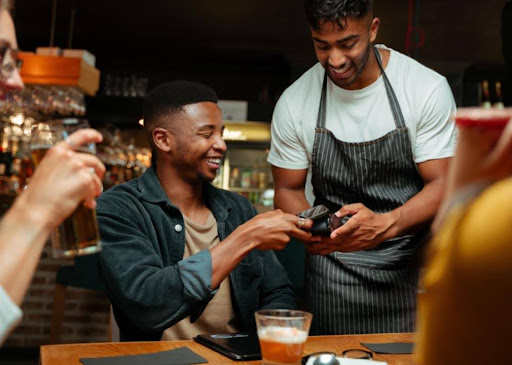Is a single tap or scan all it takes to get hired in the digital age?
Not quite. For job seekers, networking remains the key to success. Studies show people with strong networks tend to have higher salaries and get more promotions. Getting hired often starts with telling your network you’re looking for employment in hopes the query trickles down to someone who knows of an opening.
Even as technology evolves, many of the same networking rules apply. Posing an open-ended question on LinkedIn about the best advice for career growth is more tactful and effective than asking, “Hey, do you have a job for me?” An out-of-date digital profile might hurt your chances of landing a job, just as an outdated phone number on a résumé would turn away potential employers.
These networking dos and don’ts—like approaching a potential connection with courtesy, avoiding a transactional approach, and having polished credentials—emerged from traditional forms of networking, such as passing out a résumé to a prospective employer or sharing business cards at a trade show. What has changed, however, are the tools professionals need to succeed—including those taps and scans.
Uniqode researched how networking has evolved to keep pace with an increasingly digital world and interviewed recruiters, leaders of professional groups, and job seekers.
The digital revolution and the importance of ‘weak ties’ in networking
When LinkedIn launched in 2002, it targeted workers who wanted to keep in touch with their professional contacts. “People who have been working for at least 10 years have a network. It doesn’t come from networking; it just comes automatically, from going to work. But people tend to lose touch,” LinkedIn Co-Founder Konstantin Guericke told Bloomberg Businessweek in 2006.
Today, LinkedIn is the internet’s largest professional network, doubling as a job board and a social media platform. Its evolution reflects the broader trends in the future of digital services, integrating various functionalities into a single platform. Its speed and scope have transformed networking; its bookmarking feature lets users revisit profiles frequently; and, unlike physical résumés and cards, anyone with an internet connection can access a LinkedIn profile.
Filters and searches facilitate strong matches: Just browsing online in a single setting can connect recruiters looking to add you to their applicant pool or job seekers looking for people in their field with the site’s over 830 million users.
Digital connections allow for more “weak ties,” acquaintances at arm’s length, or strangers who have a mutual friend in common. A 2022 Harvard Business Review study suggested that such ties are the most useful connections, and new technology has made it easier to create them.
Katherine Sánchez, a recruiter in the tech and gaming industry, spoke with Stacker about the platform. Being present on LinkedIn “bolsters your chances of being found by somebody,” Sánchez said.
Not long ago, recruiters solicited job applicants in newspaper listings and met with candidates face-to-face at local establishments. Then they emailed candidates about job interviews, talked on the phone, and utilized early web databases to post listings.
Today, the recruiting process has become almost exclusively virtual, with digital platforms even offering special services to help recruiters find candidates more easily. Sánchez explained that curating your profile to match your desired job is a key skill to master. Listing the specific skills you need for a desired job throughout your profile could attract a recruiter.
“It may seem silly to add a skill like cross-functional communication, but if you put that on your profile, and then I’m doing a search where one of the key things that my hiring manager wants is cross-functional communication, I’m going to type that into LinkedIn to see if anybody has listed it underneath their skills,” Sánchez said. “So being more complete and more transparent is going to be the best way to make a really good LinkedIn profile.”
Danreb Victorio, a current job seeker, has made significant networking strides after being laid off, thanks to LinkedIn. He used the platform not only to elevate himself but grow his professional network. “Tripling down on my LinkedIn usage has increased my networking tenfold,” he said. “There are a lot of helpful people who spend a lot of time creating and promoting resources for job seekers.”
Victorio also shared how being part of a LinkedIn group in his field helped him grow his network. Membership in the group enabled him to attend a conference in his field, and Victorio gives back to the online community as a volunteer CV reviewer. “When you’re connected to people in your industry, especially on LinkedIn, and you apply to jobs at companies, it’s your network that’ll get you that referral,” Victorio said. “Simply knowing people and having them vouch for you is so paramount in all industries today.”
However, migrating job platforms and networks online has not benefited everyone. Job seekers without a social media presence or digital skills may be disadvantaged. According to a study by the American Staffing Association, nearly 7 in 10 (68%) older workers believe their age puts them at a disadvantage in their job hunt. Ageism combined with lower tech adoption can widen the gap between them and younger candidates, according to Pew Center data.
Make it easier to connect IRL
Tried-and-true networking strategies such as career fairs and in-person meetups are still effective, but even those have changed. Sánchez says employers spend much of their time at university career fairs. Students are encouraged to bring hard copies of their résumés to hand out to recruiters—but business cards with a QR Code are even more important.
“My recommendation is always for a person to have either a business card or a way for us to connect via LinkedIn right then and there,” Sánchez said. “I also bring my own business card so I can get a follow-up email after an event. It’s always about touching multiple bases and, ultimately, just a résumé in hand doesn’t do the most work that you could be doing.”
Luis Joshua Gutierrez, a freelancer in the gaming industry, recalls how a connection introduced him to a digital business card that can share your work and contact information just by scanning a QR Code or tapping it against a smartphone. “I was so impressed with how cool it was,” Gutierrez said.
“Because all you have to do is tap the card on your phone or scan the QR Code, and it takes you to a Linktree.”
Digital business cards can be more cost-effective than repeatedly printing new business cards. Fleshing out your LinkedIn, joining an online group, and getting a business card that can automatically connect you with others when you’re in person could be the key to turning a seemingly hopeless search into a victory. After all, it’s easy to feel like just a number in a sea of rejections.
“Those networks are valuable,” Guericke said. “I see business as a Darwinian enterprise. People tend to hire and make other business decisions by drawing on these personal networks. Is a job candidate honest or hard-working? You can’t tell from a résumé or even from an interview.”
Story editing by Alizah Salario. Additional editing by Kelly Glass. Copy editing by Paris Close.

















